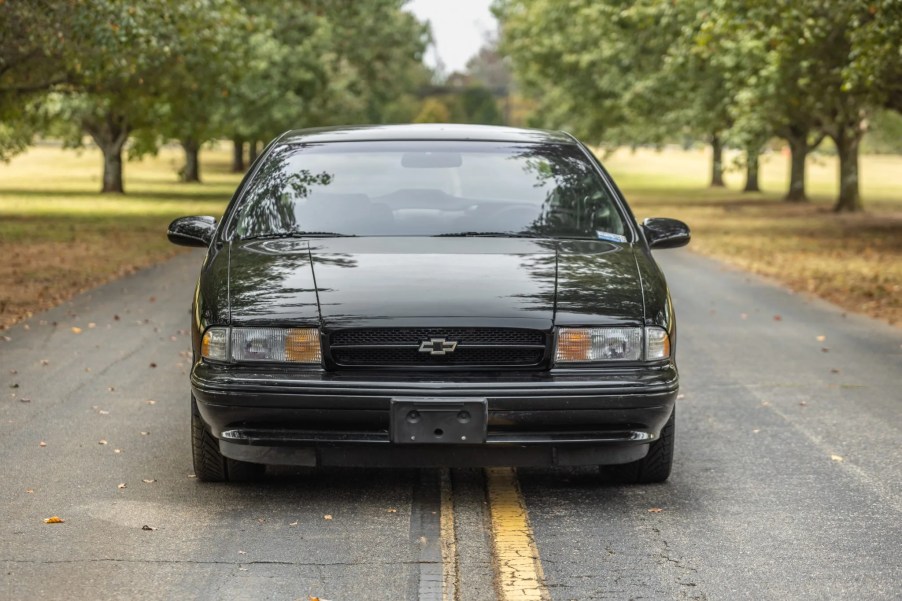
5 Reasons Why You Should Consider A 1994-1996 Chevrolet Impala SS
In the late 1950s and early 1960s, the Chevrolet Impala served as America’s blue-collar Cadillac. It was comfortable and domesticated in the base model but took on aggressive performance credentials in the upper trim levels. The Impalas of late were relegated to relaxed highway cruisers more focused on tech and entertainment than hot-rodding. Almost three decades ago, however, Chevrolet released what could have been the easiest concept car to build in its history. It was the long, low-riding, V8-powered Chevrolet Impala SS.
As they have become more popular recently, it’s essential to know why. Here are five reasons why you should consider the mid-90s Chevrolet Impala SS.
Reason #1: Lots of power
The Chevrolet Impala SS didn’t get the 8.2-liter big-block crammed in it for the 1992 Detroit Show. Instead, it received a detuned LT1 5.7-liter V8 out of the C4 Corvette with 260 horsepower and 330 pound-feet of torque. Only a few differences exist between the varying LT1s. For instance, Hagerty says that the Impala had cast-iron cylinder heads instead of aluminum, and the camshaft supported low-end torque instead of high-end horsepower. Another difference was the block casting. The Impala LT1 had a two-bolt main bearing, whereas the fourth-generation Corvette LT1 had four-bolt main bearing caps.
Reason #2: Great standard performance upgrades

In resurrecting the Impala name in the 1990s, Chevrolet based its creation on the high-performance Caprice 9C1 police package. Consequently, it got much of the equipment formerly available only to law enforcement. Upgrades included a high-capacity reverse-flow cooling system, transmission cooler, dual exhaust system, higher-output electrical system, and others. The Chevrolet Impala SS also had sport-tuned suspension with reinforced shocks and springs and four-wheel disc brakes.
Reason #3: Easy to work on
The failed-to-be-upgraded 4L60E transmission was a weak point in the Impala SS drivetrain. Therefore, any Chevrolet Impala SS with the original transmission will probably need some work done. Especially those with over 120,000 miles, ImpalaSSforum.com says. Fortunately, General Motors parts are easily acquired from junkyards, OEM equipment manufacturers, and local auto parts stores.
Reason #4: The Chevrolet Impala SS isn’t as rare as you think
The mid-90s Chevrolet Impala SS may fly under the radar with its incognito styling. But over three years, Chevrolet’s Arlington, Texas, assembly plant pumped out 69,768 sports sedans. While black was the most popular color, examples of Cherry and Dark Green Impalas can be found. Since they’re not rare, Hagerty says, “hold out for a ‘good one.’” But they also warn to “watch out for clones or replicas.”
Reason #5: It’s a practical classic that will go up in value

Even though the Impala SS is over 25 years old, it’s a very usable classic car. The Impalas had the necessary creature comforts of air conditioning, a tape deck, comfy seats, and acres of room inside. It’s also nice to know the car will increase in value as you own it. Hagerty explains that the values of stock examples in “#1 Concourse condition” have risen by nearly one-third over the past few years. Those in the “Excellent” condition bracket have also increased in value, now selling in the $20,000 range.
How much is a 1994-1996 Chevrolet Impala SS?
As mentioned above, a Chevrolet Impala SS in pristine condition will fetch bigger bucks. However, examples lower in the pecking order are affordable for those looking to get into classic cars. Autotrader shows that a few Impalas are listed for under $20,000, but most are above that mark.


